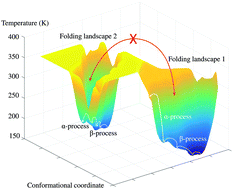Abstract
The β-relaxation associated with the sub-glass transition temperature (Tg,β) is attributed to fast, localised molecular motions which can occur below the primary glass transition temperature (Tg,α). Consistent with Tg,β being observed well-below storage temperatures, the β-relaxation associated motions have been hypothesised to influence protein stability in the solid state and could thus impact the quality of e.g. protein powders for inhalation or reconstitution and injection. Why then do distinct solid state protein formulations with similar aggregation profiles after drying and immediate reconstitution, display different profiles when reconstituted following prolonged storage? Is the value of Tg,β, associated with the β-relaxation process of the system, a reliable parameter for characterising the behaviour of proteins in the solid state? Bearing this in mind, in this work we further explore the different relaxation dynamics of glassy solid state monoclonal antibody formulations using terahertz time-domain spectroscopy and dynamical mechanical analysis. By conducting a 52 week stability study on a series of multi-component spray-dried formulations, an approach for characterising and analysing the solid state dynamics and how these relate to protein stability is outlined.



 Please wait while we load your content...
Please wait while we load your content...